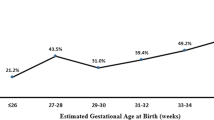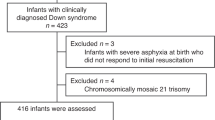Abstract
Objective:
Neonates with Down’s syndrome (nDS) may have multiple medical issues that place them at increased risk for mortality during the newborn period. Goal of this study was to determine if there are differences in baseline characteristics, medical complications or procedures performed during hospitalization between nDS who survived versus those who died during initial hospitalization.
Study Design:
Data from 2000 to 2014 were reviewed using the Pediatric Health Information Systems (PHIS) database on all DS patients admitted to the hospital <30 days postnatal life. Baseline demographics, medical complications, procedures performed and mortality were recorded. Patients were divided into nDS patients who were discharged alive (nDS-a) versus nDS patients who died (nDS-d). Multivariate logistic analysis with odds ratios was performed to determine significant predictors of death. A P<0.05 was considered significant.
Results:
A total of 5737 nDS were evaluated. Overall mortality was 7.5% (431/5737). nDS-d were more likely than nDS-a to have a lower birth weight (1.0 (0.9 to 1.0)), presence of a diaphragmatic hernia (6.9 (1.9 to 25.1), or a cardiac diagnosis of a pulmonary venous abnormality (6.8 (1.9 to 24.4)), Ebstein’s anomaly (3.2 (1.2 to 8.5)) or left-sided obstructive lesion (2.0 (1.3 to 3.0). nDS-d were more likely to develop hydrops (5.7 (3.5 to 9.5)) and necrotizing enterocolitis (1.7 (1.2 to 2.6)). In addition, nDS-d had significantly higher odds of requiring mechanical ventilation (20.7 (9.9 to 43.1)) or extracorporeal membrane oxygenation (8.7 (4.7 to 16.1)).
Conclusions:
A number of characteristics, specifically certain cardiac diagnosis, place nDS at increased risk for mortality. Furthermore, development of specific medical complications or need for particular procedures increases the odds for mortality in nDS. Caregivers should be cognizant that they are taking care of a high-risk population nDS with an increased risk for mortality if these variables are present.
This is a preview of subscription content, access via your institution
Access options
Subscribe to this journal
Receive 12 print issues and online access
$259.00 per year
only $21.58 per issue
Buy this article
- Purchase on Springer Link
- Instant access to full article PDF
Prices may be subject to local taxes which are calculated during checkout
Similar content being viewed by others
References
Canfield MA, Honein MA, Yuskiv N, Xing J, Mai CT, Collins JS et al. National estimates and race/ethnic-specific variation of selected birth defects in the United States, 1999-2001. Birth Defects Res A Clin Mol Teratol 2006; 76 (11): 747–756.
Freeman SB, Torfs CP, Romitti PA, Royle MH, Druschel C, Hobbs CA et al. Congenital gastrointestinal defects in Down syndrome: a report from the Atlanta and National Down Syndrome Projects. Clin Genet 2009; 75 (2): 180–184.
Weijerman ME, de Winter JP . Clinical practice. The care of children with Down syndrome. Eur J Pediatr 2010; 169 (12): 1445–1452.
Freeman SB, Taft LF, Dooley KJ, Allran K, Sherman SL, Hassold TJ et al. Population-based study of congenital heart defects in Down syndrome. Am J Med Genet 1998; 80 (3): 213–217.
Zachor DA, Mroczek-Musulman E, Brown P . Prevalence of celiac disease in Down syndrome in the United States. J Pediatr Gastroenterol Nutr 2000; 31 (3): 275–279.
Cua CL, Blankenship A, North AL, Hayes J, Nelin LD . Increased incidence of idiopathic persistent pulmonary hypertension in Down syndrome neonates. Pediatr Cardiol 2007; 28 (4): 250–254.
Weijerman ME, van Furth AM, van der Mooren MD, van Weissenbruch MM, Rammeloo L, Broers CJ et al. Prevalence of congenital heart defects and persistent pulmonary hypertension of the neonate with Down syndrome. Eur J Pediatr 2010; 169 (10): 1195–1199.
Weijerman ME, van Furth AM, Vonk Noordegraaf A, van Wouwe JP, Broers CJ, Gemke RJ . Prevalence, neonatal characteristics, and first-year mortality of Down syndrome: a national study. J Pediatr 2008; 152 (1): 15–19.
Kucik JE, Shin M, Siffel C, Marengo L, Correa A . Trends in survival among children with Down syndrome in 10 regions of the United States. Pediatrics 2013; 131 (1): e27–e36.
Goldman SE, Urbano RC, Hodapp RM . Determining the amount, timing and causes of mortality among infants with Down syndrome. J Intellect Disabil Res 2011; 55 (1): 85–94.
Shin M, Kucik JE, Correa A . Causes of death and case fatality rates among infants with down syndrome in metropolitan Atlanta. Birth Defects Res A Clin Mol Teratol 2007; 79 (11): 775–780.
Sparks TN, Griffin E, Page J, Pilliod R, Shaffer BL, Caughey AB . Down syndrome: perinatal mortality risks with each additional week of expectant management. Prenat Diagn 2016; 36 (4): 368–374.
Backes CH, Nicholson L, Rivera BK, Swier N, Marshall W, Cua CL . Extracorporeal membrane oxygenation incidence, characteristics, and outcomes in neonatal down syndrome patients. ASAIO J 2016; 62 (4): 477–481.
Boghossian NS, Hansen NI, Bell EF, Stoll BJ, Murray JC, Laptook AR et al. Survival and morbidity outcomes for very low birth weight infants with Down syndrome. Pediatrics 2010; 126 (6): 1132–1140.
Cashen K, Thiagarajan RR, Collins JW Jr, Rycus PT, Backer CL, Reynolds M et al. Extracorporeal membrane oxygenation in pediatric trisomy 21: 30 years of experience from the extracorporeal life support organization registry. J Pediatr 2015; 167 (2): 403–408.
Frid C, Drott P, Otterblad Olausson P, Sundelin C, Anneren G . Maternal and neonatal factors and mortality in children with Down syndrome born in 1973-1980 and 1995-1998. Acta Paediatr 2004; 93 (1): 106–112.
Rasmussen SA, Wong LY, Correa A, Gambrell D, Friedman JM . Survival in infants with Down syndrome, Metropolitan Atlanta, 1979-1998. J Pediatr 2006; 148 (6): 806–812.
de Meer K, Heymans HS, Zijlstra WG . Physical adaptation of children to life at high altitude. Eur J Pediatr 1995; 154 (4): 263–272.
Durmowicz AG . Pulmonary edema in 6 children with Down syndrome during travel to moderate altitudes. Pediatrics 2001; 108 (2): 443–447.
Jensen KM, Sevick CJ, Seewald LA, Halbower AC, Davis MM, McCabe ER et al. Greater risk of hospitalization in children with Down syndrome and OSA at higher elevation. Chest 2015; 147 (5): 1344–1351.
Niermeyer S, Andrade Mollinedo P, Huicho L . Child health and living at high altitude. Arch Dis Child 2009; 94 (10): 806–811.
Niermeyer S, Shaffer EM, Thilo E, Corbin C, Moore LG . Arterial oxygenation and pulmonary arterial pressure in healthy neonates and infants at high altitude. J Pediatr 1993; 123 (5): 767–772.
Cua CL, Rogers LK, Chicoine LG, Augustine M, Jin Y, Nash PL et al. Down syndrome patients with pulmonary hypertension have elevated plasma levels of asymmetric dimethylarginine. Eur J Pediatr 2011; 170 (7): 859–863.
Freud LR, Escobar-Diaz MC, Kalish BT, Komarlu R, Puchalski MD, Jaeggi ET et al. Outcomes and predictors of perinatal mortality in fetuses with ebstein anomaly or tricuspid valve dysplasia in the current era: a multicenter study. Circulation 2015; 132 (6): 481–489.
Hagadorn JI, Brownell EA, Herbst KW, Trzaski JM, Neff S, Campbell BT . Trends in treatment and in-hospital mortality for neonates with congenital diaphragmatic hernia. J Perinatol 2015; 35 (9): 748–754.
Choudhry MS, Rahman N, Boyd P, Lakhoo K . Duodenal atresia: associated anomalies, prenatal diagnosis and outcome. Pediatr Surg Int 2009; 25 (8): 727–730.
Friedmacher F, Puri P . Hirschsprung's disease associated with Down syndrome: a meta-analysis of incidence, functional outcomes and mortality. Pediatr Surg Int 2013; 29 (9): 937–946.
Kallen B, Mastroiacovo P, Robert E . Major congenital malformations in Down syndrome. Am J Med Genet 1996; 65 (2): 160–166.
Best KE, Addor MC, Arriola L, Balku E, Barisic I, Bianchi F et al. Hirschsprung's disease prevalence in Europe: a register based study. Birth Defects Res A Clin Mol Teratol 2014; 100 (9): 695–702.
Mustafawi AR, Hassan ME . Congenital duodenal obstruction in children: a decade's experience. Eur J Pediatr Surg 2008; 18 (2): 93–97.
Suita S, Taguchi T, Ieiri S, Nakatsuji T . Hirschsprung's disease in Japan: analysis of 3852 patients based on a nationwide survey in 30 years. J Pediatr Surg 2005; 40 (1): 197–201.
Kessler U, Schulte F, Cholewa D, Nelle M, Schaefer SC, Klimek PM et al. Outcome in neonates with necrotizing enterocolitis and patent ductus arteriosus. World J Pediatr 2016; 12 (1): 55–59.
Knott EM, Gasior A St, Peter S, Snyder C . Mortality of necrotizing enterocolitis and isolated ileal perforation at a single institution over the past 40 years. Eur J Pediatr Surg 2014; 24 (5): 394–397.
Southgate WM, Annibale DJ, Hulsey TC, Purohit DM . International experience with trisomy 21 infants placed on extracorporeal membrane oxygenation. Pediatrics 2001; 107 (3): 549–552.
Author information
Authors and Affiliations
Corresponding author
Ethics declarations
Competing interests
The authors declare no conflict of interest.
Rights and permissions
About this article
Cite this article
Cua, C., Haque, U., Santoro, S. et al. Differences in mortality characteristics in neonates with Down’s syndrome. J Perinatol 37, 427–431 (2017). https://doi.org/10.1038/jp.2016.246
Received:
Revised:
Accepted:
Published:
Issue Date:
DOI: https://doi.org/10.1038/jp.2016.246
This article is cited by
-
Congenital heart disease in Down syndrome – A review of temporal changes
Journal of Congenital Cardiology (2021)
-
Impact of prenatal screening on congenital heart defects in neonates with Down syndrome in the US
Pediatric Research (2021)
-
Usefulness of Postnatal Echocardiography in Patients with Down Syndrome with Normal Fetal Echocardiograms
Pediatric Cardiology (2019)



